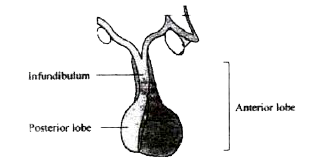Consider the following hormones
(i) Antidiuretic hormone
(ii) Aldosterone
(iii) Parathormone (iv) Oxytocin
In the vertebrate animals, the hormones involved in the control of osmoregulation would include
(i), (ii), (iii) and (iv)
(i), (ii) and (iii)
(i) and (ii)
(iii) and (iv)
The correct Answer is:C
To determine which hormones are involved in the control of osmoregulation in vertebrate animals, we will analyze each hormone mentioned in the question.
1. Identify the hormones:
- Antidiuretic hormone (ADH)
- Aldosterone
- Parathormone
- Oxytocin
2. Analyze Antidiuretic Hormone (ADH):
- ADH is responsible for regulating water balance in the body by controlling the amount of water reabsorbed by the kidneys. It plays a crucial role in osmoregulation.
- Conclusion: ADH is involved in osmoregulation.
3. Analyze Aldosterone:
- Aldosterone is known as the "salt-retaining hormone." It helps maintain water and electrolyte balance by promoting sodium reabsorption in the kidneys, which indirectly affects water retention.
- Conclusion: Aldosterone is also involved in osmoregulation.
4. Analyze Parathormone:
- Parathormone (or parathyroid hormone) regulates calcium levels in the blood and has no direct role in water balance or osmoregulation.
- Conclusion: Parathormone is NOT involved in osmoregulation.
5. Analyze Oxytocin:
- Oxytocin is primarily involved in reproductive functions, such as stimulating uterine contractions during labor. It does not play a role in osmoregulation.
- Conclusion: Oxytocin is NOT involved in osmoregulation.
6. Final Assessment:
- The hormones involved in osmoregulation are ADH and Aldosterone.
- Therefore, the correct answer is option C: "first and second" (ADH and Aldosterone).
Final Answer:
C: First and Second (Antidiuretic hormone and Aldosterone)
---
- Antidiuretic hormone (ADH)
- Aldosterone
- Parathormone
- Oxytocin
- ADH is responsible for regulating water balance in the body by controlling the amount of water reabsorbed by the kidneys. It plays a crucial role in osmoregulation.
- Conclusion: ADH is involved in osmoregulation.
- Aldosterone is known as the "salt-retaining hormone." It helps maintain water and electrolyte balance by promoting sodium reabsorption in the kidneys, which indirectly affects water retention.
- Conclusion: Aldosterone is also involved in osmoregulation.
- Parathormone (or parathyroid hormone) regulates calcium levels in the blood and has no direct role in water balance or osmoregulation.
- Conclusion: Parathormone is NOT involved in osmoregulation.
- Oxytocin is primarily involved in reproductive functions, such as stimulating uterine contractions during labor. It does not play a role in osmoregulation.
- Conclusion: Oxytocin is NOT involved in osmoregulation.
- The hormones involved in osmoregulation are ADH and Aldosterone.
- Therefore, the correct answer is option C: "first and second" (ADH and Aldosterone).
C: First and Second (Antidiuretic hormone and Aldosterone)
Topper's Solved these Questions
- CELL- THE BASIC UNIT OF LIFE ( CELL AND ITS STRUCTURAL ORGANISATION )BOOK - TRUEMEN BIOLOGY ENGLISHCHAPTER - CELL- THE BASIC UNIT OF LIFE ( CELL AND ITS STRUCTURAL ORGANISATION )EXERCISE - MULTIPLE CHOICE ANSWER TYPE
308 Videos
- EXCRETORY PRODUCTS AND THEIR ELIMINATIONBOOK - TRUEMEN BIOLOGY ENGLISHCHAPTER - EXCRETORY PRODUCTS AND THEIR ELIMINATIONEXERCISE - MULTIPLE CHOICE OUESTIONS
191 Videos
Similar Questions
Explain (i) Tropic hormone.
(ii) Hormone
(iii) Diabetes insipidus
View SolutionConsider the following antibiotics
(i) Erythromycin
(ii) Ofloxacin
(iii) Chloramphenicol
(iv) Penicillin
The pair of bactericidal antibodies is
View SolutionConsider the following compounds :
(i) sulpher dioxide
(ii) hydrogen peroxide
(iii) ozone
Among these compounds, those which can act as bleaching agents would include :
View SolutionConsider the following structures :(i) Notochord(ii) Nerve cord(iii) Pharyngeal gill slits(iv) Tail.How many features are present in larva urochordates?
View SolutionConsider the ollowing statement about SN1 reaction
(i) it is a bimolecular reaction
(ii) it proceeds with retention as well as inversion of the configuration.
(iii) It involves the fomrationn of an intermediate cabocation
(iv) The reaction is carried in the presence of polar aprotic solvents
View Solution(a) Draw a sectional view of human ovary. Label the following parts :
(i) Primary follicle.
(ii) Secondary oocyte.
(iii) Graafian follicle.
(iv) Corpus luteum.
(b) Name the hormones influencing follicular development of corpus luteum.
View SolutionGroup the following into cold blooded or warm blooded animals.
i) Sea horse (ii) horse
(iii) frog (iv) lizards
(v) birds
View SolutionHow many of the following hormones are synthesised by the hypothalamus ?
(I) growth hormone releasing hormone
(II) prolactin inhibitory hormone
(III) Thyroid stimulating hormone
(IV) aldosterone
(V) luteinizing hormone
(VI) follicle stimulating hormone
View SolutionThe diagram given below represents an endocrine gland in the human body. Study the diagram and answer the following questions :

(i) Identify the endocrine gland. Where is it located?
(ii) Why is the above gland referred to as the 'Master gland' ?
(iii) Name the hormone which in deficiency causes Diabetes Insipidus. How does this disorder differ from Diabetes Mellitus ?
(iv) Explain the term 'Hormone'.
What is the role of Tropic hormones in the human body?
(v) Which lobe of the above gland secretes:
1. Oxytocin
2. ACTH
3. Growth hormone.
View SolutionDwarfism occurs when there is
(i) Over secretion of growth hormone
(ii) Under secretion of growth hormone
(iii) Over secretion of somatostatin
(iv) Under secretion of somatostatin
View Solution
